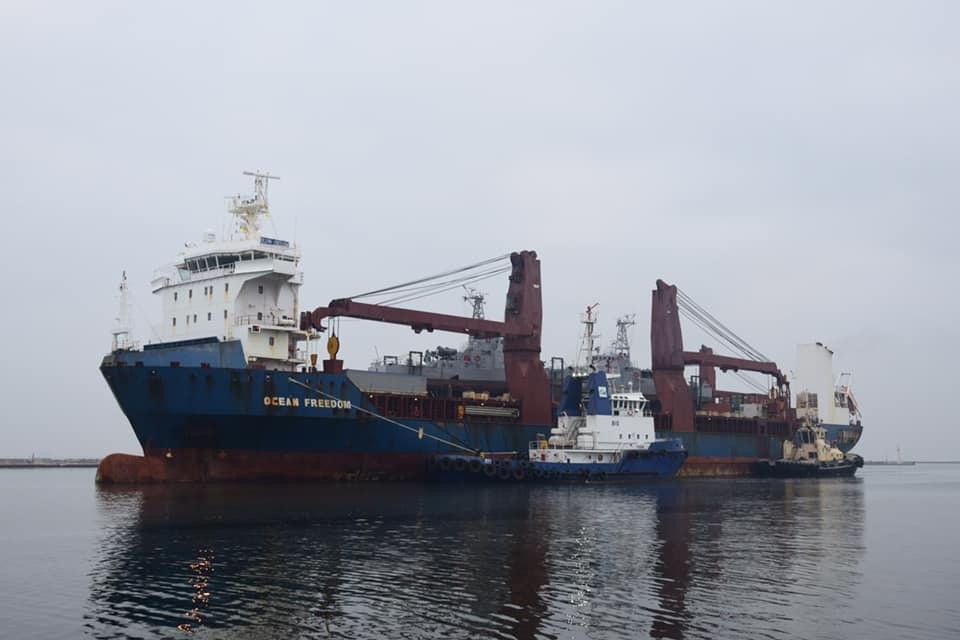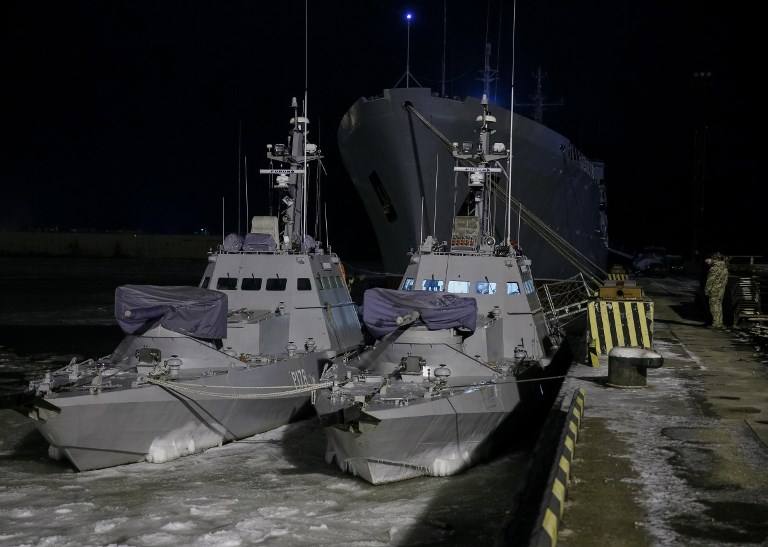Two Island-class patrol boats given to the Ukrainian Navy as part of non-paid military assistance from the United States have finally been transported to Ukrainian shores after years of delays and preparations.
The boats’ transfer to Ukraine’s navy was reportedly delayed by the Poroshenko administration since 2014 to protect defense contracts given to the Kuznya Na Rubalskomy, a Kyiv-based shipyard owned by the former president.
According to Ukraine’s navy, the vessels are currently being unloaded and prepared for use in Odesa after a 17-day-long trip. “Upon the completion of the works to make them ready for service, the Island-class boats will start their new operational record in ensuring maritime security in the aquatic areas of the Black and Azov seas, under a Ukrainian command,” the Ukrainian military reported.
The two Island-class boats, formerly operated by the U.S. Coast Guard, have been given names in honor of two Ukrainian cities in Donbas: R190 Slovyansk (after the city in Donetsk Oblast, the site of the first major battle in Russia’s war in the region) and R191 Starobilsk (after a city in Luhansk Oblast 380 kilometers southeast of Kyiv)
Slovyansk and Starobilsk are capable of reaching speeds up to 29.5 knots (54 kilometers per hour) and hold crews up to 18 members, including three commanding officers.

Ocean Freedom cargo vessel carrying the Island-class boats being towed to the port of Odesa upon its arrival on Oct. 21, 2019 (Andriy Zahorodnyuk/Facebook)
Their armaments include a 25-millimeter M242 Bushmaster chain gun and two 12.7-millimeter M2 Browning machine guns.
They have the cruising range of 5,360 kilometers and are capable of staying self-contained in the sea for 5 days.
49 of these 168-ton cutters were built by Louisiana-based Bollinger Shipyards between 1985 and 1992. 37 of them are still in active use, mostly by the U.S. Coast Guard.
The two cutters granted to Ukraine were commissioned in 1988 and were previously named WPB-1323 Drummond (now R190 Slovyansk) and WPB-1321 Cushing (now named R191 Starobilsk).
With the U.S. Coast Guard, Slovyansk participated in a number of operations in the Gulf of Mexico and the Carribean Sea, including search and rescue missions, interdiction of illegal migrants and drug smugglers and law enforcement at fisheries.
At varying times, she was based at Port Canaveral, Key West base and Miami Beach. In 1992, 1994 and 2005 her crew was awarded the U.S. Coast Guard Meritorious Unit Commendation for their role in safe interdictions of thousands of Haitian and Cuban immigrants at sea.
Her last homeport as an American military vessel was San Juan, Puerto Rico.
Cushing, now running under the name Starobilsk, conducted patrol missions around the U.S. east coast and was based in Atlantic Beach, North Carolina. In 2017, she was decommissioned.
The U.S. Coast Guard aims to eventually replace the whole class of Island cutters with more advanced Sentinel-class vessels.
Ukraine accepted the American boats in 2014, when the Pentagon reportedly suggested that the vessels be handed over under the Excess Defense Article Program (EDAP) to bolster Ukraine’s dwindling navy, which had lost nearly 80% of its power in Russia’s annexation of Crimea.
The deal was not known to the general public.
In late March 2018, the Schemes journalism project revealed the proposal from Washington and that the transfer had remained stalled for four years amid bureaucratic hurdles in the Ukrainian government.
According to the investigation, the Ukrainian military command officially submitted a letter requesting the mentioned patrol vessels to the U.S. Office of Defense Cooperation in 2015. The only remaining step was for the Ukrainian Cabinet of Ministers to issue a decree giving the Ministry of Defense the green light to accept the boats.
Nonetheless, the Ukrainian government delayed the decision for years amid never-ending bureaucratic ping-pong.
According to Schemes’ sources in Washington, the transfer was intentionally hog-tied under claims that it “contradicts the mercenary interests of Ukraine’s leadership.”
The acceptance of the Island-class cutter was believed to endanger defense production contracts given to the Kuznya Na Rubalskomy, a Kyiv-based shipyard owned by then-President Petro Poroshenko and Ihor Kononenko, his long-time friend, business partner and first deputy chairman of Poroshenko’s 139-member faction in the Verkhovna Rada.
The dockyard, the country’s only enterprise manufacturing such vessels, produces Gurza-class artillery boats for Ukraine’s navy at the cost of nearly $30 million per vessel.
Meanwhile, the market price for each of the Island-class vessels in their present condition is estimated at $25 million per unit.
In the last few years, Poroshenko’s Kuznya produced seven Gurza-class boats, two of which were attacked and seized by Russian forces during the Nov. 25, 2018 incident in the Kerch Strait. Despite their nature as river gun vessels, the Gurza-class boats are operated as seagoing patrol boats in a fashion similar to Island-class cutters.

Two Ukrainian gunboats, similar to those seized by Russia, seen in the Azov Sea port of Mariupol, on Dec. 2, 2018. (AFP)
Accepting the two American cutters could reduce the navy’s demand for patrol vessels, and based on these revelations, the Schemes’ journalists concluded that the transfer was deliberately stalled in order to ensure Poroshenko’s business was not deprived of multimillion contracts to produce more Gurza-class boats.
While the Poroshenko administration declined to comment on the case, saying it was not connected to the country’s defense production, the naval command accused Schemes of revealing sensitive information that was “beneficial to the aggressor.”
Following the media uproar, Poroshenko decried the investigation as “fake” and “incorrect” and vowed that the Island-class vessels would soon join the Ukrainian navy after completing “internal state procedures for the completion and approval of the draft contract that we received from the American side.”
In late September 2018, Poroshenko unexpectedly announced he would sell the shipyard to a buyer later identified as Serhiy Tihipko, a businessman and former vice prime minister who served under ousted former president Viktor Yanukovych.
The transfer, nonetheless, only started moving forward after the Schemes revelation, and on Sept. 12, 2018, the Cabinet of Ministers finally approved an agreement to accept the Island boats.

Ukraine’s top naval commander Ihor Voronchenko and U.S. Coast Guard Vice Admiral Michael F. McAllister sign certificates handing-over the Island-class patrol boats in Baltimore on Sept. 27, 2018. (Mikhail Palinchak)
Later the same month, the U.S. Coast Guard officially handed over the boats to the Ukrainian navy in a ceremony at the Port of Baltimore.
The boats’ arrival on Ukrainian shores was even more eagerly awaited as maritime confrontations surged in 2018, with Russia monopolizing the Sea of Azov and harassing commercial ships and Ukraine’s beleaguered navy able to provide only a very weak response.
The aid comes to Ukraine at no cost, although Kyiv was to spend nearly $10 million to reactivate, equip and transport the vessels from Baltimore to Odesa. By September 2019, the U.S. Coast Guard had also completed a 10-week training for 32 Ukrainian sailors selected as crewmembers for the patrol boats.
“These warships, in combination with well-trained Ukrainian crews, will enhance the power of our navy,” Ukraine’s Defense Minister Andriy Zagorodnyuk said regarding the cutters’ arrival on Oct. 21.
“As part of our maritime force, such boats will allow for conducting more effective patrol missions in the (Ukrainian aquatic areas), to uphold anti-sabotage defense and participate in search-and-rescue operations.”
